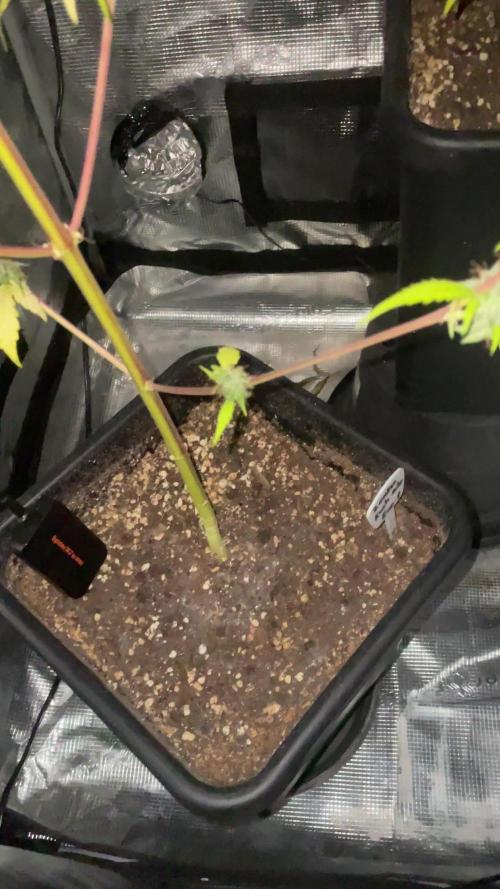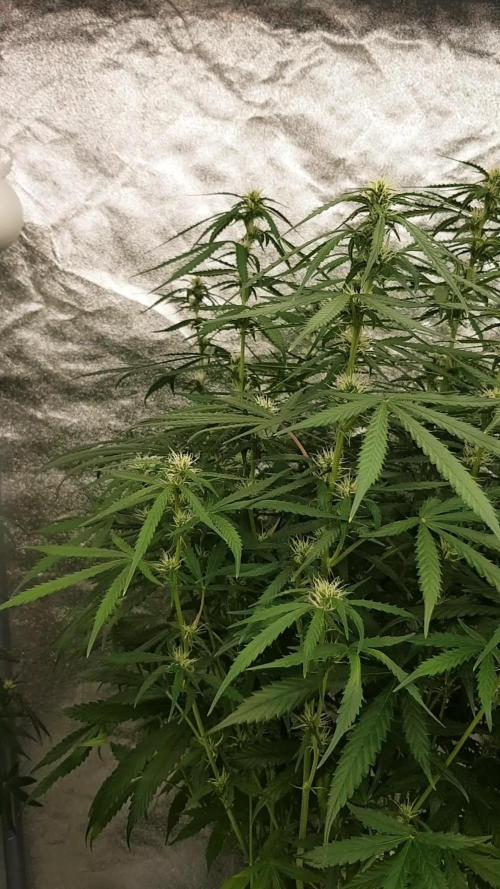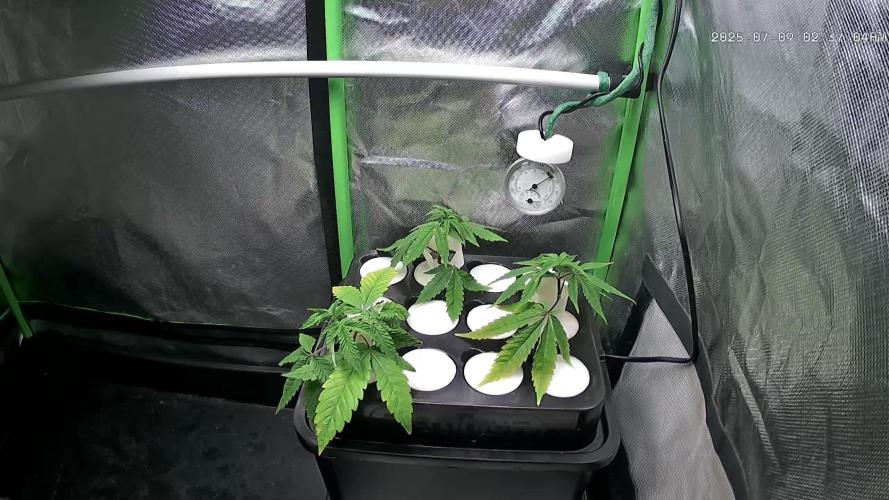The Grow Awards 2026 🏆 

































Likes
Comments
Share


@GrowGuy97
Follow
(Roughly) Day 83 from seed, Day 28 of Flower- Ladies are getting EXTREMELY frosty already so I can only imagine how they will look towards harvest! Overall extremely happy with how these ladies have done, have not had any issues out of them at all! Can’t wait to see what the bud looks like! Thanks for following & happy growing friends!✌️🏼🙏🏼🌱
Likes
2
Share


@Pabloauyanet
Follow
Después de un arduo trabajo estamos en la última semana de fertilización
Processing
Likes
16
Share


@Matahierbas
Follow
This week all I wanted to see some kind of growth and I kinda see it, they both still look sad , the first plant looks like it's doing "ok" I do see new roots developing so that's a good sign.
The 2nd plant still some brownin' appears on some leaves I don't know BUT I do see new roots growing on her my question is: should I still keep her going? OR let her get the axe?
The deficiency still appears and I've done everything on the book but don't wonna give up on her (just yet) but I really don't know what to do with her? I wonna give her sometime see what she tells me or if u guys know what am doing wrong I would greatly appreciate
Likes
35
Share


@Kellykush420
Follow
This week I found fungus gnats I added sticky boards and mosquito bits. A small amount of fading on oldest leaves. I did a small defoliation of the yellow fan leaves. I added bone meal to the top layer of soil and worked it in. Water at 6.5.
Likes
43
Share


@DoDrugs420
Follow
NOTE: THE COUNTING OF DAYS STARTS FROM THE DAY THE SEED STARTS ITS PROCESS, IN THIS GROW DAY 1 WAS THE MOMENT THE SEED GOT INSERTED INTO THE EASY START (i do not recomend this method for experienced growers, but higly recomend it to unexperienced growers that might accidentally damage their seedling's new root as they move them from the germination zone into their next or final pot, with easy start you can just pick up the small cube of soil and place it inside the next pot GENTLY).
NOTE: For strain informations, soil recipe and nutrient's stock please do check "Germination Week" as you will find all the information there. (Do not replicate nutrient dosages as these are higly variable depending on the conditions within the grow room or tent, so you may end up damaging or killing your plants even if they are the same strain from the same breeder).
--------------------------------------------------------------------___________________________________________________________-----------------------------------------------------------------------_____________________________________________________________________----------------------------------------------------------------
28/10- All watered with 75ml to 85ml of water with the nutrients in the above concentrations.
29/10- Transplanted now as the soil is in perfect condition between wet and dry and plants start to get a little big for their pots, since i expected them to be rootbound before the day after next watering i decided on transplanting earlier and let them fill the 11l pots right away, i only started in smaller pots as to use a lighter soil since the soil i mixed is for the main pots its some HOT ASS soil. Increased the light's height to maintain plant to light distances. Didn't water yet since i had used water to break down the coco bricks and while mixing the soil the moisture got into all of it, so there is enough humidity to maintain them like this for 1 or 2 more days, i will decide on that tomorrow. Plant height before transplant was 8 to 10 cm, i burried it down to 5 again as to spare some vertical space and try to avoid an emergency tent upgrade (highly unlikely if everything goes well, but i am getting ready for it, because with my luck i may expect 1m plants and somehow have a SOG of 1,4m plants basically clubbing with the light, i hope not, but we never know).
31/10- On these ones i switched it up with 250ml of water per plant with dilluted nutrients in the ratios of:
Bio Rhizotonic- 4ml/l
pH Perfect Micro- 0.30ml/l
Ancient Earth Organic- 1ml/l
Followed right after of 500ml of plain water per plant.
Seems to have done the trick for GG2, much more colorfull by now, however GG1 is being stubborn and keeps on pushing weird-al leaves, but still pushing leaves, imma keep this one just for the sake of it. if it doesn't work out i can always replace it later on, i just wanna see how her structure at the end of veg is and if she will produce flower, if flower production is there even tho not optimal, i will still grow it just to check out if there is any DNA damages caused by heat that could of modify the cannabinoid profile in relation to the other one.
Likes
8
Share


@Kaotic_Herb
Follow
What's happening viewers. Texas had a line of thunderstorms and tornadoes this past week. Winds grew up to more than 20mph. WISDOM the White Widow and her sister Patience the mystery strain to the right, lived through every drop . The rain allowed the ladies to flush naturally and ready for dinner. Keep it locked because the mother Annie the Afghan will pop up any minute now. Y'all stay cool.
Likes
2
Share


@Comfrey
Follow
Die Woche verging wie im Fluge. Purple Punch Auto glitzert in den Morgenstunden wunderschön und verströmt einen sehr angenehmen Duft. Momentan duftet diese hier von unseren vier Pflänzchen am stärksten.
Die Blüten schwellen nach einem krassen Stretch an. Das intensive LST und das Entfernen störender Blätter hat dazu geführt, dass die Blüten sehr gleichmäßig Sonnenlicht bekommen und später in der Blüte die Luft gut zirkulieren kann.
Zwei Tage der Woche standen die Pflanzen unter der Markise, es hat über Stunden heftig geregnet.
Nachdem ich meine Grashüpfer letzte Woche umgesiedelt habe, der Fraß ging mir zu weit, sehen die nachwachsenden Pistillen wieder gut aus. Vorher wurden die von den Hüpfern gerne angeknabbert.
Das Gießen läuft wie gewohnt nach Gefühl. An heißen Sonnentagen bis zu 1,5 Liter.
Soweit die News von unserem Balkon, die nächsten Wochen werden vergehen und dann ist die erste Saison als Weed Gärtner auch schon wieder beendet.
Likes
12
Share


@GrowBrosInc
Follow
Took as much of the lower growth of the two plants that I can reach. I think I did a pretty good job for my first time. Cant wait to see how she focuses the energy on the canopy. The canopy itself is within 3-4 inches of each top with each getting a lot of light. I think the last of the pre flower stretch is over but if it isnt im still good with the second scrog. Pulled the two humidifiers and added a small humidifier as well as a 350 sq ft DeHum. Hoping to really keep the humidity low for her to get really frosty.
Thanks for checking out the grow! Any comments, or advice is always welcome! 😁
Processing
Likes
23
Share


@Organic_LarF
Follow
Hello,
This beautifull threesome of ladies have been bend over this week. As new(2) lights are on there way, they need to be trained a bit so the space would fill up (3×3 or 90x90).
Ive tried first to chiroprac 1 of them but it was still very flexible, so I took some rope and started bending. But I reflected first to now what I intend to reach.
As a result, they really bended very far and ive opend up a hole new set of branches to grow better faster stronger. 🤖
Looking forward to the new grow pattern!
Grow safe
🍀🍀🍀
Likes
11
Share


@The_Wanderer
Follow
Anthocyanin-rich cold tea for antioxidants
#plantmedicine #antioxidants #herbalmedicine #antiinflamitory #holistichealth #herbaltea #cannabisextraction #coldinfusion
Likes
33
Share


@AshBrand
Follow
This strain gave us no problems, very simple to grow! The plants both stayed small and bushy until flower, then they took off. We will be back to adjust the weight and add more comments.
8/14/21 - The buds are done curing and it’s 🔥 Smooth and flavorful 💨 We finally smoked it and couldn’t finish a joint lol. It’s a lot stronger than we anticipated. I love indica strains and this is now one of my favorites. Next up we have 2 Lemon Kush and 2 Gelato growing outdoors as a side project in between indoor LED grows.
Blueberry from seedsman was so simple to grow. We messed up on a few things but we got plenty of nice buds and made 2lbs of butter for edibles.
-FIN-
Likes
Comments
Share


@Yiyis_Grow
Follow
Van madurando bien, se les siente super compactas algunas como piedra.
De momento no hay indicios de botrytis, que siempre ha sido un problema para mi.
Hoy revisé los tricomas pero ninguna está para cosechar aún, así que se quedarán una semana más.
5 con proceso de lavado y 1 todavía con nutriente.
Likes
12
Share


@CANNASIM
Follow
WEEK 1 of flower. This is insanely quick, veg for three weeks and on week 4 we are flowering strong.
It is raining a lot, so i had to use a top dressing, ingredients on the week 3, to manage the soil nutrients till the end of the cycle. About two table spoons.
Watering once a week, with the mix above, otherwise rain is taking care of them, very natural as a grow, nothing much complicated, no science fiction with fertilizer or chemistry.
I’m curious about the yield, and how much can i pull out of this way, with minimal work and a nearly inert soil. Let’s see how this experiment turns out.
Likes
3
Share


@Ninjabuds
Follow
7I wish they didn't make me do this to get a smileI wish they didn't make me do this to get a smileI wish they didn't make me do this to get a smileI wish they didn't make me do this to get a smileI wish they didn't make me do this to get a smileI wish they didn't make me do this to get a smileI wish they didn't make me do this to get a smileI wish they didn't make me do this to get a smileI wish they didn't make me do this to get a smileI wish they didn't make me do this to get a smileI wish they didn't make me do this to get a smileI wish they didn't make me do this to get a smile
Likes
11
Share


@Mcdiggley420
Follow
Day 30 and girls are In need or another lst big time photos to be up loaded later alls looking well slight discolouration on blue dream 1 but I'll see how she pulls trough
Lst video up gsc growing slower than the blue dream so tied the blue dream alot more trying to level things out.
Likes
20
Share


@GERGrowDesigns
Follow
Dear Growers ,
Welcome to Week 6 or Flower Week 3 // Day 42-49 from Kannabia Baby Auto .
Incase of Moving to a New Home . I Decided to skip 3-4 Weeks from every Diarie of the 12x12 Automatic Project . Everything should be Normal in the next Weeks .
Whether you're a beginner or an expert, you are warmly invited to join, ask questions, and share your own experiences along the way!
Project Setup & Conditions:
• Brand/Manufacturer: Kannabia Seeds
• Tent: 222cmx150cmx150cm
• Light: 2x 720 Watt Full Spectrum
• Humidity: 50%
• Soil: Narcos Organix Mix
• Nutrients: Narcos Products
• pH Value: 6
If you want Germinitation results like mine , check out Kannabia Seeds with my link [https://www.kannabia.com/de?ref=61966] and grab the germination device or the strains I used . Trust me – it’s worth it for sure !
Get another 20% Discount at all products using the code [GGD] at the Checkout
Stay curious and keep up Growing —we look forward to welcoming you back for the next chapter soon!
Likes
Comments
Share


@Lynx_361
Follow
07.07.2025
Flowering day 9 and rooting day 9. Both, flowers and roots show up now.

























